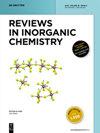点击 "化学在 MOF 架构开发中的变革性应用 - 综述
IF 3.1
3区 化学
Q1 CHEMISTRY, INORGANIC & NUCLEAR
引用次数: 0
摘要
金属有机框架(MOFs)融合了引人注目的多孔结构、诱人的物理和化学属性以及广泛的应用可能性。利用这些有机成分的固有能力为构建 MOF 铺平了道路,允许通过适当的反应进行富有想象力的预先设计和合成后调整。这种适应性不仅丰富了 MOFs 的结构种类,还为定制其特性以满足精确应用需求开辟了道路。在此背景下,点击化学已成为创造和改性各种功能材料的有效而灵活的工具,在 MOF 结构中的应用前景广阔。通过应用 "点击 "化学,这些 MOF 结构可以进行合成后修饰。这种方法以其高效性和选择性为特点,被证明有助于定制和增强 MOF 的特性,从而扩大其在科学和工业应用领域的效用。在此,我们将阐明通过 "点击 "化学的后合成应用而实现的最新 MOF 结构。我们将深入探讨推动后合成修饰过程的前沿策略,重点关注这些修饰过的 MOF 结构的复杂性、合成方法和应用前景。我们的目的是积极推动关于点击化学在 MOF 结构开发中的应用的持续讨论,鼓励科学家们为这些多功能材料的发展奉献自己的专业知识和努力。本文章由计算机程序翻译,如有差异,请以英文原文为准。
Transformative applications of “click” chemistry in the development of MOF architectures − a mini review
Metal-organic frameworks (MOFs) represent a fusion of compelling porous structures, alluring physical and chemical attributes, and extensive possibilities for application. The inherent capability of employing these organic constituents has paved the path for the construction of MOFs, permitting imaginative pre-design and post-synthetic adjustments through apt reactions. This adaptability not only enriches the structural variety of MOFs but also uncovers pathways for customizing their characteristics to align with precise application needs. In this context, click chemistry has emerged as a potent and resilient tool in the creation and modification of diverse functional materials, with a promising application in MOF structures. These MOF architectures undergo postsynthetic modifications through the application of “click” chemistry. This approach, characterized by its efficiency and selectivity, proves instrumental in tailoring and enhancing the properties of MOFs, thereby expanding their utility across a spectrum of scientific and industrial applications. Herein, we illuminate recent MOF structures achieved through the postsynthetic application of “click” chemistry. Our exploration delves into the forefront of strategies propelling the postsynthetic modification process, with a dedicated focus on the structural complexities, synthesis methodologies, and the prospective applications of these modified MOF architectures. Our intention is to actively contribute to the continuous discourse on applications of click chemistry in the development of MOF architectures, encouraging scientists to dedicate their expertise and efforts towards the advancement of these multifunctional materials.
求助全文
通过发布文献求助,成功后即可免费获取论文全文。
去求助
来源期刊

Reviews in Inorganic Chemistry
化学-分析化学
CiteScore
7.30
自引率
4.90%
发文量
20
审稿时长
1 months
期刊介绍:
Reviews in Inorganic Chemistry (REVIC) is a quarterly, peer-reviewed journal that focuses on developments in inorganic chemistry. Technical reviews offer detailed synthesis protocols, reviews of methodology and descriptions of apparatus. Topics are treated from a synthetic, theoretical, or analytical perspective. The editors and the publisher are committed to high quality standards and rapid handling of the review and publication process. The journal publishes all aspects of solid-state, molecular and surface chemistry. Topics may be treated from a synthetic, theoretical, or analytical perspective. The editors and the publisher are commited to high quality standards and rapid handling of the review and publication process.
Topics:
-Main group chemistry-
Transition metal chemistry-
Coordination chemistry-
Organometallic chemistry-
Catalysis-
Bioinorganic chemistry-
Supramolecular chemistry-
Ionic liquids
 求助内容:
求助内容: 应助结果提醒方式:
应助结果提醒方式:


